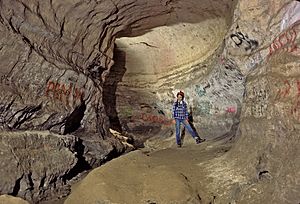Tongue River Cave facts for kids
Tongue River Cave is a cool underground place found in the Bighorn National Forest in Wyoming. It used to be famous for its amazing cave formations, like stalactites and stalagmites, and for the special animals that lived there. However, over the years, too many visitors, vandalism, and people taking pieces of the cave have caused a lot of damage. Because of this, the U.S. Forest Service now manages it as a "sacrifice cave." This means they accept that it's been changed and focus on managing it for visitors, rather than trying to fully restore its original state.
In 2010, the cave was closed for a while to stop the spread of a bat disease called White nose syndrome. It has since reopened, but now you need to register and clean your clothes and gear before you go inside. This helps protect the cave and its wildlife.
Contents
What is Tongue River Cave Like Inside?
Tongue River Cave is carved into a type of rock called Bighorn dolomite. Experts mapped the cave in 1969 and found it has about 1.23 miles of passages. The deepest part of the cave goes down 106 feet!
The cave mainly has two river channels. One channel is no longer active, meaning water doesn't flow through it anymore. The other channel is still active and is actually an underground part of the Little Tongue River. This river then comes back to the surface farther down the Tongue River Canyon.
About half a mile into the cave, these two channels meet in a big room called the Boulder Room. The upper, dry channel is mostly sandy and ends in a chamber filled with sand. The lower, active stream passage starts in a deep pool of water and ends in a very narrow crack. People have tried to explore the underwater parts of the cave, but the water is super cold, and it's hard to carry all the scuba gear through the tight passages.
How Does Water Flow Through the Cave?
In 1974, scientists put a special dye into the Little Tongue River about 2.6 miles south of the cave. The dye later showed up inside the cave's river! This proved that the Little Tongue River is indeed the source of the water flowing through Tongue River Cave.
Inside the cave, you can find waterfalls where the water has worn away softer rock. One of these is a 24-foot drop called Big Falls. Rain and melting snow on the surface also make the river level inside the cave rise. Sometimes, the water level can go up a lot, even days after it rained or snowed outside. Flash floods in the cave are very rare, though.
What's the Weather Like in the Cave?
The temperature inside Tongue River Cave stays at a constant 50 degrees Fahrenheit, which is about 10 degrees Celsius. It's also almost 100% humid, meaning the air is very moist.
About 750 feet into the cave, the main passage gets very narrow, forming a tight crawl space. When the air pressure inside the cave tries to balance with the air pressure outside, it creates strong winds in this narrow spot. Near the cave's entrance, the cool cave air meets the warmer outside air. This causes condensation, like dew forming, and creates a spot called the Rain Room. Here, water droplets constantly fall from the ceiling.
Who Lives in Tongue River Cave?
Two types of bats used to live in Tongue River Cave, but they are not seen as often now. These bats are the Townsend's big-eared bat (Plecotus Townsendii) and the Fringed myotis (Myotis thysanodes). They have probably moved to other cave areas that are less visited by people. There are also some shy cave rats that live in the lower crawlways near the cave's entrance.


